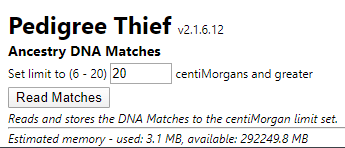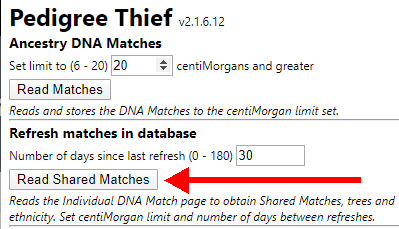[As of June 2020, Pedigree Thief no longer downloads from Ancestry.]
Pedigree Thief is a free chrome extension that used to download your DNA matches and shared matches from Ancestry. It no longer works for this purpose.
Check out our tutorial on an alternative way to copy your Ancestry matches to an Excel spreadsheet.
What Else Does Pedigree Thief Do?
The tool allows you to transfer pedigree data into Genome Mate Pro and Gedcom. If that’s what you’re after, this review isn’t for you. Read on if you want to explore an option for exporting your matches and shared matches.
How It Used To Work
In contrast, I used Pedigree Thief this week (March 2020) to download my matches at 20+ cM, along with their shared matches. This is no longer possible.
The rest of this article is a review that is no longer applicable.
Getting Started – the Match Download
The Help document that comes with the extension is clear and easy to follow. It took me a few minutes to install, have a quick read, and start my downloads.

The first screen you see is for a basic download of matches.
You can choose your centimorgan threshold or keep the default of 20 cM.
This basic Match Download is super fast. It shows progress clearly, and the count runs upwards very quickly. It took 3 1/2 minutes for me to download one thousand matches, but the information that it grabs is limited. If you choose to download the match file on completion, you’ll get this basic info:
match name, admin name, centimorgans, segments, gender, match kit ID
So no tree information, no ethnicity, and no shared matches. The real meat is in the “Read Shared Matches” feature that becomes available once you’ve run the match download.

Specify your centimorgan range
I’ll note at this point that Pedigree Thief is not blindingly fast when reading Shared Matches. So if you want to give it a try out, I suggest you keep the default 20 cM range before going for the full house.
Your ancestry “flashing before your eyes”
It will become clear early on as to how this application collects shared matches, when your chrome tab starts chopping and changing. Pedigree Thief starts at the top of your matches, and opens each match page one by one to grab tree info, ethnicity and shared matches. Here it is on my 7th match:

How long does the Shared Match download take?
The extension page reports that it “reads about 480 matches per hour“.
On my first try at downloading for my 20+ cM matches, I watched the progress for a while. Then I opened another browser tab and did a bit of surfing. When I toggled back to the Thief tab, I noticed the progress dial hadn’t moved much. This is the drawback of a chrome extension: the performance will be limited based on other activity both within chrome itself, and elsewhere on your computer. With toggling back and forth and doing other stuff, it took an hour to download for my 130 matches.
So I decided to start again and give the extension as much of my laptop’s memory and power as possible. I uninstalled the extension, deleted its database, and reinstalled. I closed every other chrome tab, and all other applications.
So Pedigree Thief downloaded 420 matches in one hour on my machine. Factors such as my internet speed and Ancestry’s own website performance are going to be a drag of course. So I’m happy to accept 480 per hour as an optimal rate. (Update: the extension author has added some details in a comment below).
The full match data from Pedigree Thief
So you’ve already got this info from the basic match download: match name, admin name, centimorgans, segments, gender, match kit ID. This is the additional match info you get when you’ve done the full download to include shared matches:
linked tree URL, linked tree size, linked tree surnames, ethnicity, notes
The match download is a csv file, which you can import into Microsoft Excel, Open Office Calc, Google Sheets etc. A typical row in my file looks like this:

Tree Information
The download includes tree sizes for linked and unlinked public trees. The tree URL is only present for linked trees.
The “altTree” field is a mystery to me. The help document says that it indicates that “a viewable tree exists whether linked or not”. (Update: the extension author has added some details in a comment below).
The shared match data from Pedigree Thief
And this is what an entry in the shared match file looks like (ICW stands for “In Common With” and is another moniker for “shared match”):

Is that it?! Well, yes. The shared match file gives you the unique IDs of a match and its shared matches. To figure out which matches these refer to, you’ve got to refer back to the main match file. You may prefer a combined view of the data rather than to keep searching another spreadsheet to see more information about each shared match. Getting there with Pedigree Thief will require some technical skills e.g. in spreadsheets or database or coding. Keep reading for an alternative.
Hi.
I am the creator of Pedigree Thief and I just wish to thank you for your extensive and fair review of it’s capabilities in respect of reading matches from Ancestry.
You mention the the altTree field. This should show ‘True’ if one or more unlinked trees are available but on checking, I see it is not consistent. I’ll investigate and issue and update in due course.
When reading Shared Matches, to get maximum speed, as you discovered, you should leave the browser on the tab created by Pedigree Thief. I usually leave it running overnight so next morning it will have visited about 3500 – 4500 matches. You can re-start it the next evening and it will continue where it ended. For myself, I can (re-)read all my matches down to 12cMs in one night and down to 10cMs the following night. The statistics csv file gives an indication of the likelihood of finding shared matches for each centiMorgan level. In my case, below 10cMs it’s less than 1 shared match in 20 read so I only refresh these every 90+ days or so.
Finally, I should mention that, from a Match page, you can read a single match and PT will produce a csv of that match and any shared matches associated with it.